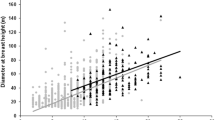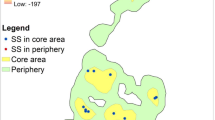Abstract
Between 1984 and 1987, we recorded the sleeping-site and lodge tree preferences of night monkeys at the Beni Biological Station, Bolivia. We characterized the structure of sleeping-site compared lodge trees to nonlodge trees, and determined the frequency of their use. Aotus azarae used branch and liana platforms on trees of the middle strate of the forest as sleeping sites, but the lodge trees provided sparse cover. Monkeys may manipulate either natural accumulations of material or bird nests to serve as sleeping sites. The characteristics of the sleeping site and of the lodge trees may be related to protection against predators and to thermal advantages. The distribution of lodge trees appeared to be related to access to food. Activities around the sleeping site could be related to marking behavior.
Similar content being viewed by others
References
Aquino, R., and Encarnacion, F. (1986). Population structure ofAotus nancymai (Cebidae: Primates) in Peruvian Amazon lowland forest.Am. J. Primatol. 11(1): 1–7.
Aquino, R., and Encarnacion, F. (1992). Characteristics and use of sleeping sites inAotus (Cebidae: Primates) in the Amazonian lowlands of Peru (in press).
Beck, S. G. (1984). Comunidades vegetales de las sabanas inundadizas en el NE the Bolivia.Phytocoenologia 12(2/3): 321–350.
Braza, F. (1980). El Araguato rojo (Alouatta seniculus), Doñana Acta Vertebrata, Vol. 7-5, special num. thesis.
Braza, F., Alvarez, F., and Azcarate, T. (1981). Behavior of the red howler monkey (Alouatta seniculus) in the llanos of Venezuela.Primates 22(4): 459–473.
Coimbra-Filho, A. F. (1977). Natural shelters ofLeontopithecus rosalia and some ecological implications (Callitrichidae: Primates). In Kleiman, D. G. (ed.),Biology and Conservation of the Callitrichidae, Smithsonian Institution Press, Washington, D.C., pp. 79–89.
Dahl, J. F., and Smith, E. O. (1985). Assessing variation in the social behavior of Stumptail macaques using thermal criteria.Am. J. Phys. Anthropol. 68: 467–477.
Dahl, J. F., Bernstein, I. S., and Williams, L. E. (1986). Thermoregulation and social structure of a captive group of Rhesus Macaques. In Taubf, D. M., and King, F. A. (eds.),Current Perspectives in Primate Social Dynamics, Van Nostrand Reinhold, New York, pp. 243–251.
Dixon, W. J. (1975).BMDP Biomedical Computer Programs, University of California Press, Berkeley.
Dixon, W. J. (1981).BMDP Statistical Software, University of California Press, Berkeley.
Ellembergh, H., and Mueller-Dombois, D. (1965). Tentative physiognomic-ecological classification of plant formations of the hearth.Ber. Geobot. Inst. ETH, Stiftg Rubel Zurich, 37: 22–47.
Garcia, J. E. (1988).Patrones Etologicos y Ecologicos del Mono Nocturno, Aotus azarae boliviensis, Ph.D. thesis, University of Valencia, Spain.
Garcia, J. E., and Braza, F. (1987). Activity rhythms and use of space of a group ofAotus azarae in Bolivia during the rainy season.Primates, 28: 337–342.
Hershkovitz, P. (1983). Two new species of night monkeys, genusAotus (Cebidae, Platyrrhini): A preliminary report onAotus taxonomy.Am. J. Primatol. 4: 209–243.
Kinzey, W. G. (1981). The titi monkeys, genusCallicebus. In Coimbra-Filho, A. F., and Mittermeier, R. A. (eds.),Ecology and Behavior of Neotropical Primates, Vol. 1, Acad. Bras. Cien., Rio de Janeiro, pp. 241–273.
Kinzey, W. G., Rosenberger, A. L., Heisler, P. S., Prowse, D. L., and Trilling, J. L. (1977). A preliminary field investigation of the yellow handed titi monkey,Callicebus torquatus torquatus, in northern Peru.Primates 18: 159–181.
Lawick-Goodall J. van. (1971).In the Shadow of Man, William Collins Sons, Glasglow.
Liberman, M. (1985).Mapa de la Vegetacion: Estacion Biologica Beni, Laboratorio de Cartografia y Fotointerpretacion, Instituto de Ecologia, La Paz, Bolivia.
Mason, W. A. (1966). Social organization of the south American monkey,Callicebus moloch: A preliminary report.Tulane Stud. Zool. 13: 23–28.
Mason, W. A. (1968). Use of space byCallicebus groups. In Jay, P. (ed.),Primates: Studies in Adaptation and Variability, Holt Rinehart and Winston, New York, pp. 200–216.
Mateucci, S. D., and Colma, A. (1982).Metodologia para el Estudio de la Vegetacion. Secretaria General de la Organizacion de Estados Americanos.Serie Biologia Monografia, 22: 1–168.
Napier, F., and Napier, P. A. (1967).A Handbook of Living Primates, Academic Press, London.
Rathbun, G. B., and Gache, M. J. (1977).The Status of Aotus trivirgatusin Argentina Centro Argentino de Primates y el Instituto Nacional de la Salud, Washington, D. C.
Schaller, G. B. (1964).The Year of the Gorilla, University of Chicago Press, Chicago.
Terjung, W. H. (1966). Physiologic climates of the coterminous United States: A bioclimatic classification based on man.Ann. Am. Geog. Assoc. 16: 141–176.
Thorington, R. W., Jr., Muckenhirn, N. A., and Montgomery, G. G. (1976). Movements of wild night monkeyAotus trivirgatus. In Thorington, R. W., Jr., and Heltne, P. G. (eds.),Neotropical Primates, Natl. Acad. Sci., Washington, D.C., pp. 32–34.
Wright, P. C. (1978). Home range, activity pattern and agonistic encounters of a group of night monkeys (Aotus trivirgatus) in Peru.Folia Primatol. 29: 43–55.
Wright, P. C. (1981). The night monkeys, genusAotus. In Coimbra-Filho, A. F. and Mittermeier, R. A. (eds.),Ecology and Behavior of Neotropical Primates, Vol. 1, Acad. Bras. Cien., Rio de Janeiro, pp. 211–240.
Wright, P. C. (1983). Day-active night monkeys (Aotus trivirgatus) in the Chaco of ParaguayAm. J. Phys. Anthropol. 60(2): 272.
Author information
Authors and Affiliations
Rights and permissions
About this article
Cite this article
Garcia, J.E., Braza, F. Sleeping sites and lodge trees of the night monkey (Aotus azarae) in Bolivia. International Journal of Primatology 14, 467–477 (1993). https://doi.org/10.1007/BF02192777
Received:
Accepted:
Issue Date:
DOI: https://doi.org/10.1007/BF02192777




